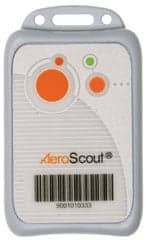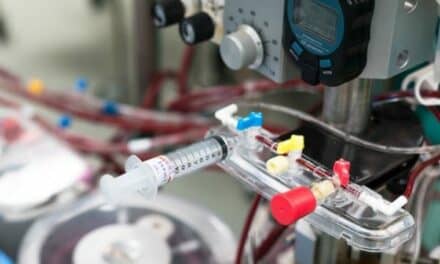Radio frequency identification (RFID) is undoubtedly one of the new frontiers that clinical engineers and biomedical equipment technicians will have to cross in the coming years. RFID and the tags used in the systems typically allow equipment to be tracked remotely, making equipment management and inventory control easier, less time consuming, and profitable—by eliminating losses through transfers, misplacement, or even outright theft.
“It can be a real nightmare if you can’t find a piece of equipment,” says Barbara Christe, MS, program director, biomedical engineering technology, and associate professor, Engineering Technology Department, Indiana University Purdue University, Indianapolis.
Hospitals are slowly recognizing the value of an RFID system. According to a survey conducted by the ECRI Institute, 5% of hospitals have an RFID system in place, 8% are in the process of implementing one, and 40% plan to do so in the next 2 years.
While the tags have generated a lot of buzz, they also are transmitting concern among biomeds and hospital administrators who worry that the radio-controlled tags could interfere with life-supporting equipment such as infusion pumps. Though the technology is in its relative infancy, medical researchers are working hard to disprove these fears.
According to Christe, clinical and biomedical engineers need to be aware that the potential for interference comes from the antenna and not the tag, and two factors need to be considered with the antenna: frequency and distance. Antennas can be in the wall, ceiling, or anywhere in a facility. The antennas send a signal that wakes up the RFID tag. The tag gets the energy, says “Here I am,” sends the signal back, and the computer gets it. When some kinds of antennas send out energy, a large magnetic field can be created. RFID can cause electromagnetic interference because the antenna generates radio waves that create a magnetic field, and that can interfere with electronics. There are limitless scenarios and variables, and different frequencies have different issues.
 |
| A common misconception is that the tag causes interference, but the potential for interference comes from the antenna. |
THE SUM OF ALL FEARS
Many of the fears that there will be interference or another failure of the system are born partially out of the need to have a foolproof, error-free system. This is not possible, according to Dara McLain, an EMC specialist and CEO of Nomad EMC Consulting, Crawfordville, Fla. “Anything wireless is not foolproof,” she says. “If you look at the manuals, they’ll tell you that if you want absolute control, it has to be wired.”
Christe, who has studied the effects of RFID interference, concedes that the antennas can cause interference under certain conditions, but biomeds and hospital managers need to consider the cost-benefits of having the systems in place. And while, from a physics perspective, it is possible that RFID can cause interference, it is not certain that it will. “If you’re looking for a black and white answer, there is none,” she says.
There has been evidence that there are some possibilities for interference, but in many cases it was caused by the proximity of the RFID antenna to the equipment being tested. Distance is a critical factor. Christe notes that the farther away the antenna, the less signal strength and the less possibility of a problem.
Victor Sarmiento, a veteran biomed, adds that interference depends on how much power you are emitting from the antenna. Tags generally do not emit enough electromagnetic interference to impact the performance of a device. However, an overly cautious biomed could dampen the tag, effectively silencing it. “You have to consider how you’re going to package the RFID tag in the device. If you don’t do it right, the device will act like shielding [and the tag won’t work],” he says.
Tag placement is very important. Water and fluids can absorb the “wake up” signal from the antenna, and metal can reflect the signal. If the tag does not receive the signal at all, it might be assumed the tag (and the attached device) is not present.
Sarmiento says this is not the first time he has seen this sort of debate. In the 1990s, there were similar concerns surrounding cell phones in the hospital setting. That debate has, for the most part, resolved itself. In his experience, Sarmiento has found that changes in the atmosphere can be a factor in causing interference.
He even speculates that the problem may not be a matter of physics alone. “It could be all hype,” he says. “Politics in the hospital can play a part. The technology itself is good.”
McLain, too, was involved in the cell phone debate at the turn of the century. “In 2000, I went to a wireless conference, and on one side of the panel I was on were the manufacturers, and on the other were hospitals. The hospitals wanted to ban cell phones. It was all a huge witch hunt. It’s the same thing with RFID. It’s all relative,” she says.
Also at issue, according to Christe, is the way the RFID systems have been tested. “They’re kind of like car crash tests. It’s just one type of crash, and not every type of crash,” she says, meaning that researchers have discovered a way to cause interference, but they cannot identify every way to cause interference. However, the tests conducted in real-world situations have shown that there is typically no interference caused by RFID antennas or tags when systems are configured in practical, likely scenarios. And it is the real-world tests—not the laboratory ones—that hold weight with Christe.
WHY RFID?
Christe says that even with the controversy RFID technology has generated in some circles, there are compelling reasons to use it. RFID tags used in patient care areas to monitor the whereabouts of newborns not only make them safer but also add peace of mind. These systems use active tags—ones with batteries embedded in them—to broadcast a signal.
The other type of tags—passive ones—absorb power from RFID antennas when they are in range. These tags require antennas with a higher power output. A passive tag “pings” an antenna when it passes in front of it. Typically, antennas are arrayed in key areas, such as doorways or ceilings.
Another beneficial way to use RFID tags is in the operating room, particularly with sponges, which can be left inside a patient and cause serious complications. Handheld scanners can be passed over a patient and activate the passive RFID tag. These scanners do not send out a continuous signal. Instead, they require the operator to depress the “on” switch and keep it on. This eliminates the potential for any harmful interference generated by a continuous signal.
When there are problems, they are typically due to users not following manufacturer guidelines when setting up the system.
WHAT TO DO?
McLain says there are a number of ways to eliminate the potential problems associated with RFID tags. “First, you need to look at the frequency and the effective radio power (ERP) on any of the devices,” she says. “See how much it produces and how much it’ll tolerate. Every electronic device will have these specifications.”
McLain says that there are a couple rules of thumb to consider when installing an RFID antenna system: Make sure that the antennas are far enough apart not to cause any problems, and consider the distance of coverage.
But it is not just antenna placement that has to be considered. The biomed will have to choose the kind of tag that should be placed on the device. While they both have their advantages and disadvantages—a passive chip needs a more powerful antenna, while an active chip does not, but the passive chip never runs out of power and the active chip’s batteries will wear out—there is no compelling reason to use one over the other, according to McLain.
While the theory of RFID tags makes sense, how they fare in real conditions is the most important consideration for hospital administrators and the clinical/biomedical engineers in charge of the equipment.
RFID IN ACTION
Genesis Medical Center, a four-hospital system headquartered in Davenport, Iowa, recently installed an RFID tag system. A pilot is currently being conducted at the 502-bed main campus.
Tim Burke, CBET, biomed manager, is in charge of the pilot program, which is testing the system’s ability to track wheelchairs and infusion pumps. Genesis administrators decided to implement the RFID system because of the “massive difficulty in locating equipment,” Burke says. “Wheelchairs were forever lost, and we determined that we own twice as many infusion pumps as we can actually find. If we could locate just 40% more of our infusion pumps we’d be saving money.”
The goal of the pilot is to test the accuracy of the system and the biomeds’ ability to be able to find the chair or pump once it pings an antenna. Accuracy is put at ±10 meters. Thus far, Burke’s team has been having little difficulty tracking down errant wheelchairs. “We’re getting some false hits, but using a little common sense, close is truly good enough,” he says.
The Genesis system uses active RFID tags and has been integrated into the existing Cisco-based Wi-Fi system. The decision to do this was because the Wi-Fi coverage in the hospital was already good and the hospital wanted to take advantage of that. Thus far, there have been few glitches due to using the existing system.
The problem of interference was addressed prior to implementation. Burke says he reviewed the research conducted by the ECRI Institute and the results of an ad hoc test conducted by an engineer at AeroScout, a provider of active RFID technology, to test the effect of an RFID tag on an infusion pump. The result of that ad hoc test showed that the pump’s safety and accuracy were unaffected when an active tag was placed on it.
Though the pilot has not caused any problems with the infusion pumps used by Genesis, Burke says that anything electronic will be tested before it is fitted with an RFID tag.
Aiding in the success of the pilot is the fact that the administration has supported the idea of having the system. “That’s the upside; everything is in our favor to succeed,” Burke says. “The only way we can fail is if the error rate is more than 10 meters or if the equipment goes missing completely.”
The biomeds have been doing some “destructive testing,” trying to see how far the system can be pushed. They have failed on this point, much to Burke’s pleasure. “The system has done a beautiful job,” he says.
Burke does know how high the stakes are with the Genesis pilot program. He recently sat in on a conference call with a hospital using an RF and infrared system. This hospital’s system was a complete failure with a failure rate of 70%.
Burke expects that the Genesis system will go live in the early part of 2009, though that date could change depending on how well the pilot program shakes out. “I’m fairly optimistic that once we’ve tagged all of our wheelchairs and infusion pumps, we’ll be in a hurry to add other devices,” he says.
While Genesis Medical Center is proving in a very practical way the value of an RFID system, there are still concerns about interference—but that might be a thing of the past, thanks to researchers at Missouri University of Science and Technology.
SIGNAL COLLISION
The device researchers at Missouri University of Science and Technology developed increases read rates, reduces read errors, and improves system coverage in RFID systems. The system eliminates RFID signal collision by adjusting the reader power in response to interference levels.
According to the researchers, the technology uses distributed adaptive power control and probabilistic power control schemes to adjust the reader power output in response to signal collision, which occurs when multiple readers try to read the same tags or when antenna are situated too close together. Currently, the university is searching for commercial backers to develop the technology and bring it to market.
While this is promising and provides that black-and-white guarantee that will win over more administrators and biomeds to the use of RFID tags to track equipment, patients, and even personnel, the reality is that it may all be just a tempest in a teapot.
McLain notes that companies take patient safety very seriously and spend a lot of time and resources testing and researching new equipment with the aim of releasing products that are beneficial.
As for the problems of interference, she says that it can be avoided by following vendor recommendations and specifications. “I can make anything fail [by not following the specifications], and that’s why there are specifications,” she says.
But the bottom line is that when implementing an RFID system, hospitals and biomeds need to look at the totality of the environment and not one or the other as separate. “If you’re only looking at RFID, you’re only getting half the picture,” McLain says.
C.A. Wolski is a contributing writer for 24×7. For more information, contact .





